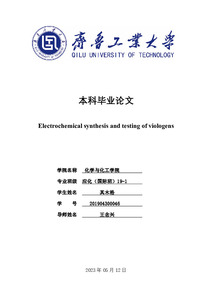Electrochemical synthesis and testing of viologens
Qi, Muge (2023)
Qi, Muge
2023
All rights reserved. This publication is copyrighted. You may download, display and print it for Your own personal use. Commercial use is prohibited.
Julkaisun pysyvä osoite on
https://urn.fi/URN:NBN:fi:amk-2023061123454
https://urn.fi/URN:NBN:fi:amk-2023061123454
Tiivistelmä
Water pollution is an ever-growing concern worldwide, and wastewater treatment has become increasingly important as a result. Fenton's reagent, developed by British chemist Joseph Fenton in 1894, is a cost-effective and sustainable technology for treating wastewater. It works by using hydrogen peroxide to produce hydroxyl radicals that can break down organic contaminants. However, its weak redox properties limit its efficacy, making it less effective than other treatment technologies available today.
To address this issue, researchers have been exploring ways to improve the redox properties of Fenton's reagent without compromising its many benefits. In this study, they investigated the addition of violet essence material, which is a type of carbon- based nanomaterial that has excellent electrical conductivity, thermal conductivity, mechanical strength, and chemical stability. Violet essence materials have already been widely used in solar cells, supercapacitors, and other fields due to their exceptional properties.
The researchers aimed to explore the potential of combining Fenton's reagent with violet essence material to enhance its redox properties, thus increasing its efficiency in treating wastewater. They used three different ratios of Fenton's reagent and violet essence to polymerize composite films onto glassy carbon electrodes or indium tin oxide (ITO) glass electrodes for electrochemical testing. The results showed that the optimal ratio was 2:1, and scanning electron microscopy confirmed that the composite film was uniformly distributed on the electrode surface and had a porous structure.
The differential pulse voltammetry images revealed that the composite films polymerized on ITO electrodes using violet-refined material were more stable and resilient, with better sustainability and optical characteristics. However, the high cost and scarcity of metals present in ITO glass make large-scale practical applications challenging.
In conclusion, the study found that combining Fenton's reagent with violet essence material has significant potential in polymerization electrochemistry research and could be a game-changer in wastewater treatment. As technology and research progress, the benefits of these materials will continue to be explored in more depth, leading to even more applications in fields such as environmental protection and green energy production.
To address this issue, researchers have been exploring ways to improve the redox properties of Fenton's reagent without compromising its many benefits. In this study, they investigated the addition of violet essence material, which is a type of carbon- based nanomaterial that has excellent electrical conductivity, thermal conductivity, mechanical strength, and chemical stability. Violet essence materials have already been widely used in solar cells, supercapacitors, and other fields due to their exceptional properties.
The researchers aimed to explore the potential of combining Fenton's reagent with violet essence material to enhance its redox properties, thus increasing its efficiency in treating wastewater. They used three different ratios of Fenton's reagent and violet essence to polymerize composite films onto glassy carbon electrodes or indium tin oxide (ITO) glass electrodes for electrochemical testing. The results showed that the optimal ratio was 2:1, and scanning electron microscopy confirmed that the composite film was uniformly distributed on the electrode surface and had a porous structure.
The differential pulse voltammetry images revealed that the composite films polymerized on ITO electrodes using violet-refined material were more stable and resilient, with better sustainability and optical characteristics. However, the high cost and scarcity of metals present in ITO glass make large-scale practical applications challenging.
In conclusion, the study found that combining Fenton's reagent with violet essence material has significant potential in polymerization electrochemistry research and could be a game-changer in wastewater treatment. As technology and research progress, the benefits of these materials will continue to be explored in more depth, leading to even more applications in fields such as environmental protection and green energy production.
